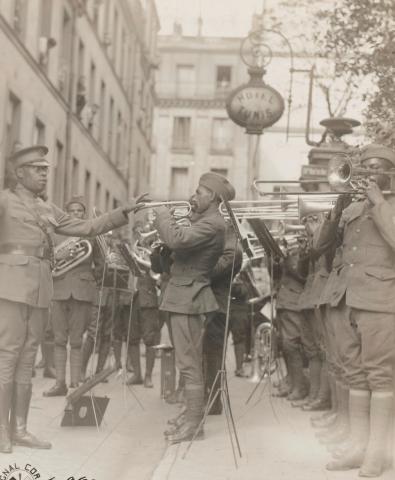For Jazz Appreciation Month, the American Battle Monuments Commission (ABMC) honors one of the most famous regimental bands of World War I—the regimental band of the 369th U.S. Infantry[1], led by Lt. James Reese Europe.
Europe joined the regiment at the request of the Regimental Commander to form a band. He was already a famous musician leading the Clef Club band since 1912. He also arranged musical numbers and performed with Irene and Vernon Castle, a famous dance duo of the time.
Europe’s band was known for playing the new musical genres of the era, Ragtime, along with Jazz. When he recruited for the regimental band he sought out those musicians he had worked with before from the best bands in New York.
Europe was an officer in the Machine Gun Company of the regiment in addition to his duties as bandleader. In this role, he was the first Black officer to cross into No Man’s Land, which inspired a tune he wrote “On Patrol in No Man’s Land.”
The 369th Infantry chose a rattlesnake as their insignia and were known as the “Rattlers” or “Black Rattlers.” However, they are best known by the name given by their German enemies, “Hell Fighters,” or the “Harlem Hell Fighters” as history came to remember them. Their band, led by Europe, performed for crowds both military and civilian and is credited with bringing Jazz to the French. Jazz music and the legacy of the “Hell Fighters” band continue to this day through a recording of all the 1919 performances by the band.
While Europe survived the war, many members of the 369th did not. Today, there are 169 members of the regiment buried or memorialized at several ABMC cemeteries, the majority at Meuse-Argonne American Cemetery.
The ABMC’s mission is to honor the service of the U.S. Armed Forces by creating and maintaining memorial sites, commemorating their service and sacrifice, and facilitating the education of their legacy to future generations.
The ABMC was founded in 1923 following World War I, and its 26 cemeteries and 31 monuments honor the service men and women who fought and perished during World War I, World War II, the Korean War and the Vietnam War, as well as some who fought during the Mexican-American War. The contributions of men like Europe and his fellow band members as well as all of those who have served with ABMC over the last 100 years, continue to move the agency and its mission forward.

Sources: ABMC Historical Services/ NARA
[1] The 369th was the designation given to the 15th Regiment, New York National Guard, a segregated African-American unit from Harlem, N.Y., when they were federalized for service in World War I.
 An official website of the United States government. Here's how you know.
An official website of the United States government. Here's how you know. 